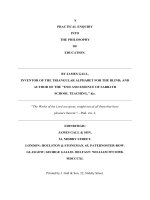Frontier orbitals a practical manual
Bạn đang xem bản rút gọn của tài liệu. Xem và tải ngay bản đầy đủ của tài liệu tại đây (10.78 MB, 304 trang )
FRONTIER ORBITALS
A PRACTICAL MANUAL
Nguyên Trong Anh
Formerly Research Director at CNRS
and Professor at the École Polytechnique, France
FRONTIER ORBITALS
FRONTIER ORBITALS
A PRACTICAL MANUAL
Nguyên Trong Anh
Formerly Research Director at CNRS
and Professor at the École Polytechnique, France
Copyright © 2007
John Wiley & Sons Ltd, The Atrium, Southern Gate, Chichester,
West Sussex PO19 8SQ, England
Telephone (ϩ44) 1243 779777
Email (for orders and customer service enquiries):
Visit our Home Page on www.wileyeurope.com or www.wiley.com
All Rights Reserved. No part of this publication may be reproduced, stored in a retrieval system or transmitted in any form
or by any means, electronic, mechanical, photocopying, recording, scanning or otherwise, except under the terms of the
Copyright, Designs and Patents Act 1988 or under the terms of a licence issued by the Copyright Licensing Agency Ltd, 90
Tottenham Court Road, London W1T 4LP, UK, without the permission in writing of the Publisher. Requests to the Publisher
should be addressed to the Permissions Department, John Wiley & Sons Ltd, The Atrium, Southern Gate, Chichester, West
Sussex PO19 8SQ, England, or emailed to , or faxed to (ϩ44) 1243 770620.
Designations used by companies to distinguish their products are often claimed as trademarks. All brand names and product
names used in this book are trade names, service marks, trademarks or registered trademarks of their respective owners. The
Publisher is not associated with any product or vendor mentioned in this book.
This publication is designed to provide accurate and authoritative information in regard to the subject matter covered. It is
sold on the understanding that the Publisher is not engaged in rendering professional services. If professional advice or other
expert assistance is required, the services of a competent professional should be sought.
The publisher and the author make no representations or warranties with respect to the accuracy or completeness of the contents
of this work and specifically disclaim all warranties, including without limitation any implied warranties of fitness for a particular
purpose. This work is sold with the understanding that the publisher is not engaged in rendering professional services. The advice
and strategies contained herein may not be suitable for every situation. In view of ongoing research, equipment modifications,
changes in governmental regulations, and the constant flow of information relating to the use of experimental reagents, equipment,
and devices, the reader is urged to review and evaluate the information provided in the package insert or instructions for each
chemical, piece of equipment, reagent, or device for, among other things, any changes in the instructions or indication of usage
and for added warnings and precautions. The fact that an organization or Website is referred to in this work as a citation and/or a
potential source of further information does not mean that the author or the publisher endorses the information the organization or
Website may provide or recommendations it may make. Further, readers should be aware that Internet Websites listed in this work
may have changed or disappeared between when this work was written and when it is read. No warranty may be created or extended
by any promotional statements for this work. Neither the publisher nor the author shall be liable for any damages arising hereform.
Other Wiley Editorial Offi ces
John Wiley & Sons Inc., 111 River Street, Hoboken, NJ 07030, USA
Jossey-Bass, 989 Market Street, San Francisco, CA 94103-1741, USA
Wiley-VCH Verlag GmbH, Boschstr. 12, D-69469 Weinheim, Germany
John Wiley & Sons Australia Ltd, 42 McDougall Street, Milton, Queensland 4064, Australia
John Wiley & Sons (Asia) Pte Ltd, 2 Clementi Loop #02-01, Jin Xing Distripark, Singapore 129809
John Wiley & Sons Ltd, 6045 Freemont Blvd, Mississauga, Ontario L5R 4J3, Canada
Wiley also publishes its books in a variety of electronic formats. Some content that appears in print may not be available in
electronic books.
Anniversary Logo Design: Richard J. Pacifico
Library of Congress Cataloging-in-Publication Data
Anh, Nguyen.
Frontier orbitals : a practical manual / Nguyen Anh.
p. cm.
Includes bibliographical references and index.
ISBN: 978-0-471-97358-4 (cloth : alk. paper)
1. Molecular orbitals. 2. Chemistry, Physical organic. I. Title.
QD461.A65 2007
541’.224–dc22
2006100392
British Library Cataloguing in Publication Data
A catalog record for this book is available from the British Library
ISBN 13 9780471973584 (Cloth) ISBN 13 9780471973591 (Paper)
Typeset in 10.5/12.5 pt Palatino by Thomson Digital
Printed and bound in Great Britain by Antony Rowe, Chippenham, Wiltshire
This book is printed on acid-free paper responsibly manufactured from sustainable forestry
in which at least two trees are planted for each one used for paper production.
To Vân Nga
To Dao, Chuong and Nam
Acknowledgments
This book would probably never have been written without the friendly insistence of
G. Bram and the help of O. Eisenstein, J. M. Lefour, A. Lubineau, Y. T. N’Guessan,
P. Metzner, J. P. Pradère and A. Sevin. I have also benefited from the vast chemical
knowledge which J. Boivin and S. Zard have regularly shared with me. Many thanks
are due to D. Carmichael for the first English draft and for correcting a number of
obscurities and numerical errors. Naturally, I am solely responsible for any mistakes
in this book.
Contents
Acknowledgments
vii
Preface
xiii
1
What Can We Do With Frontier Orbitals?
1
1.1
The Advantages of the Perturbation Method
1
1.2
The Uses of Frontier Orbitals
1.2.1 Five Standard Frontier Orbital Treatments of Reactivity
1.2.2 Three Standard Frontier Orbital Treatments of Structural Problems
2
2
3
2
Atomic and Molecular Orbitals
5
2.1
Atomic Orbitals
5
2.2
Molecular Orbitals
9
2.3
The MOs of a Homonuclear Diatomic Molecule
2.3.1 Calculations
2.3.2 A Physical Interpretation
10
10
12
2.4
MOs of a Heteronuclear Diatomic Molecule
2.4.1 Calculations
2.4.2 A Physical Interpretation
15
15
16
2.5
π MOs of Polyatomic Molecules
2.5.1 The Hückel Method for Polyatomic Molecules
2.5.2 How to Calculate Hückel MOs
16
16
21
2.6
To Dig Deeper
24
x
Contents
3
The Perturbation Method
25
3.1
Perturbations and Hückel Methods
25
3.2
Study
3.2.1
3.2.2
3.2.3
3.2.4
26
26
27
28
28
3.3
Perturbation Theory: The Practical Aspects
3.3.1 Numerical Calculations
3.3.2 Qualitative Applications
29
29
32
3.4
The Dewar PMO Method
3.4.1 Alternant Hydrocarbons
3.4.2 The Dewar PMO Method
3.4.3 Advantages and Disadvantages of the PMO Method
35
35
38
43
3.5
To Dig Deeper
44
4
Absolute and Relative Reactivities
47
4.1
Absolute Reactivity
4.1.1 Bimolecular Reactions
4.1.2 Unimolecular Reactions
48
48
52
4.2
Relative Reactivity
4.2.1 Electrophilic Reactions
4.2.2 Nucleophilic Reactions
4.2.3 Cycloadditions
57
57
60
66
4.3
Limitations of Rules 1 and 2
4.3.1 Some Difficulties Encountered with Rule 1
4.3.2 Problems with Rule 2
72
72
75
5
Regioselectivity
87
5.1
Cycloadditions
87
5.2
Electrophilic Reactions
5.2.1 Markovnikov’s Rule
96
96
of Bimolecular Reactions Using Perturbation Methods
Two-orbital Systems
Systems Having More than Two Orbitals
The Frontier Orbital Approximation
Unimolecular Systems
xi
Contents
5.2.2 Regioselectivity Involving Enols and Enolates
5.2.3 FO Theory and Ionic Reactions
96
102
5.3
Nucleophilic Reactions
5.3.1 Additions to Conjugated Carbonyl Compounds
106
106
5.4
Radical Reactions
110
5.5
Periselectivity
112
5.6
Limitations of Rule 3
113
6
Stereoselectivity
129
6.1
Pericyclic Reactions
6.1.1 Electrocyclic Reactions
6.1.2 Sigmatropic Rearrangements
6.1.3 Cycloadditions and their orientations
129
129
138
139
6.2
Addition Reactions
6.2.1 Nucleophilic Additions
6.2.2 Electrophilic Additions
6.2.3 Application to the Aldol Addition
144
144
172
175
6.3
Substitution Reactions
6.3.1 Bimolecular Electrophilic Substitutions
6.3.2 Bimolecular Nucleophilic Substitutions
178
178
178
6.4
The Limitations of Rule 4
181
7
Some Structural Problems
187
7.1
Principle of the Method
187
7.2
Stable Conformations
7.2.1 Aldehydes, Alkenes and Enol Ethers
7.2.2 Conformations of Some Ions
7.2.3 The Anomeric Effect
7.2.4 The Geminal Effect
7.2.5 The Gauche Effect
188
188
195
200
203
204
7.3
Reactive Conformations
206
xii
Contents
7.4
How
7.4.1
7.4.2
7.4.3
7.5
Bonds with Abnormal Lengths
7.5.1 Structural Consequences of HOMO–LUMO Interactions
7.5.2 Applications to Nucleophilic Additions
7.5.3 Substituent Effects
210
210
211
212
7.6
Abnormal Valence Angles
228
8
Going Further
231
8.1
The Limits of Frontier Orbital Theory
8.1.1 The Simplifying Hypotheses of Frontier Orbital Theory
8.1.2 Consequences
232
232
232
8.2
The Capabilities of Computational Chemistry
8.2.1 Structural Problems
8.2.2 Reactivity Problems
8.2.3 Beyond Potential Surfaces
235
235
235
236
8.3
The Methods of Quantum Chemistry
8.3.1 The Approximations
8.3.2 The Principal Theoretical Models
8.3.3 A Few Technical Points
237
237
238
242
8.4
To Dig Deeper
244
to Stabilize Inherently Unstable Species
Cyclobutadiene
Trimethylenemethane
Stable Carbenes
Appendix: MO Catalog
A1 Organization of the Catalog
A2 Chapter 3
A3 Chapter 4
A4 Chapter 5
A5 Chapter 6
A6 Summary Table
Index
207
207
208
209
245
245
245
247
264
276
277
281
Preface
Many chemical phenomena cannot be explained by classical physics. Examples include
the covalent bond, the Walden inversion, the Hückel 4n ϩ 2 rule, pericyclic reactions,
C-alkylation of enolates (despite the higher charge density at oxygen), axial attack
at cyclohexanones (although the equatorial face is less hindered), the head-to-head
cyclodimerization of acrolein (through atoms having the same charge), the anomeric
effect, the cis configuration of certain enol ethers and many others. The list is lengthening by the day.
The reason is that chemical reactions occur at molecular level, so quantum mechanics is required to understand them.1 However, computational chemistry is time consuming and solves problems one by one. For teaching purposes and everyday work,
chemists need simple methods capable of giving general predictions. This book introduces the perturbation approach, the most valuable of these methods, and its simplified offspring, the frontier orbital approximation. It is based upon a course taught to
Master’s level students at the Université Paris Sud, and is aimed at experimentalists
who are well versed in organic chemistry but have little or no understanding of quantum mechanics. The theoretical sections are succinct, the mathematics is kept to a
strict minimum and, consequently, the explanations are not always totally rigorous.
Greater emphasis is put on chemistry than on quantum mechanics, and the intelligent
use of perturbation methods rather than their mathematical derivation. For example,
the three-orbital perturbation equation is given without proof, but its limits and physical significance are detailed. The successes and limitations of the FMO method are discussed extensively; an understanding of when it is likely to fail is important, because
valid results are obtained in only about 80% of cases. This is not an exceptional success
rate, but I am unaware of any other simple method which is so versatile and effective.
This book is a practical manual and is intended for tutorial classes or self-studies. Being a manual, it should provide a fi rm enough background to allow the student to understand perturbation theory, rather than using it as a black box. The exercises found
throughout the text are classified by symbols: E (easy), M (moderate), or D (difficult)
to indicate their complexity. Full solutions are given in each case. These exercises must
be considered an integral part of the course.
1
‘I had always felt – and of course still do – that the synthetic chemist would not go far unless he
were to mobilize and apply, to the best of his ability – and within the limits set by the many other
things he must know and do – the maximum in the way of principle and theory.’ (R. B. Woodward,
A. C. Cope Award address, 1973).
xiv
Preface
The organization of this manual reflects a desire to be practical. Hence, applications are not classified by reaction families, but rather by criteria used by the synthetic
chemist: competition between reagents (relative reactivity), sites (regio- or chemoselectivity) or reaction trajectories (stereoselectivity). The steps involved in solving each
problem, such as the choice of model, the calculation of molecular orbitals and the
interpretation of results, are explained. At each stage, potential pitfalls are pointed out.
Some are trivial, others more subtle (such as mathematically valid calculations which
are physically absurd). Important points are highlighted in boxes, extended explanations are printed on a gray background and exercises stressing algebraic or numerical
manipulations are marked with asterisks, to allow them to be skipped over upon fi rst
reading. The chapters dealing with applications begin with a box explaining the rules
which they illustrate, and can be read independently. Cross-references are used to offset the potential disadvantages of such a compartmentalized structure. An Appendix
containing the necessary MOs allows those without access to a computer to work out
the exercises. The book is addressed more to students than specialists, so I have made
no attempt to cover the literature exhaustively.
Chemistry underwent an explosive development in the second half of the 20th century. It is impossible to cover all of its aspects, so I have limited myself to organic
chemistry. There remains much to be done; I hope that this book will provide the
reader with the basics needed to do it.
Nguyên Trong Anh
1 What Can We Do With
Frontier Orbitals?
1.1 The Advantages of the Perturbation Method
In essence, there are only two really important themes in chemistry: structure and
reactivity. In structural problems, we usually compare the relative stabilities of two isomers (1 and 2) or conformers (3 and 4). Their energy differences are of the order of a
few percent. Thus, benzene (1) is more stable than Dewar benzene (2) by 60 kcal molϪ1,
about 5% of its molecular energy (∼1230 kcal molϪ1).1 Similarly, trans-butadiene (3) is
more stable than cis-butadiene (4) by 2.7 kcal molϪ1, or 3% of its energy of formation.
1
2
3
4
Reactivity is governed by two fundamental quantities: the activation energy ∆E‡, given by the energy gap between the starting materials and the transition state, and the
reaction enthalpy ∆H, which is the difference between the energies of the reagents and
the products.2 Again, these differences are small. For the electrocyclization of hexatriene, the energy of the system is ∼1300 kcal molϪ1, the activation energy is ∼30 kcal molϪ1
(2.5%) and the reaction enthalpy is ∼50 kcal molϪ1 (4%).
Transition state
Activation energy
Reaction enthalpy
Typical σ bond strength is approximately 90 kcal molϪ1 and π bond strength approximately 50 kcal molϪ1.
For the moment, we will ignore the fi ner distinctions between E, H and G.
1
2
Frontier Orbitals Nguyên Trong Anh
© 2007 John Wiley & Sons, Ltd
2
What Can We Do with Frontier Orbitals?
Therefore, the chemist is usually interested in small differences between large energies, which is why perturbational approaches are particularly useful. Suppose that we
wish to calculate the activation energy of the hexatriene cyclization to an accuracy of
10 kcal. If ∆E‡ is calculated by simple subtraction, it will be necessary to evaluate the
energies of the reagent and of the transition state to a precision of 5 kcal. This means a
margin of error of 0.33%, which is only possible using highly sophisticated techniques.
Compare this with the case where we regard the transition state as a perturbed form
of the initial system, and then calculate the energy of the perturbation. This gives the
difference directly and requires a precision of only 33%, i.e. 100 times less. The perturbation method offers three advantages:
1. It provides chemically meaningful results with a minimum of effort. Simple Hückel
calculations are sufficient in many cases.
2. By treating transition states as perturbations of the starting material, it allows us to
avoid the (difficult) calculations of these unstable species.
3. It requires little equipment (these are `back of an envelope’ calculations) and
a minimum of theoretical knowledge (we only need to learn three perturbation
schemes).
However, it does require some chemical intelligence!
1.2 The Uses of Frontier Orbitals
The frontier orbital approximation3 is a special case of perturbation theory. It is very simple to use; we merely maximize the frontier orbital interactions. Its conclusions are correct in about 80% of cases, so it is not infallible. Nonetheless, to the best of the author’s
knowledge, no other simple theory applicable to a wide range of problems is any better.
Furthermore, we can predict the cases where frontier orbital theory is likely to fail.
1.2.1 Five Standard Frontier Orbital Treatments of Reactivity
Absolute Reactivity
Question: Will A react with B?
Answer: Reaction is forbidden if their frontier orbital overlap is zero.
Relative Reactivity (Including Chemoselectivity)
Question: Will reagent A react preferentially with B1 or B2?
Answer: A reacts preferentially with the molecule whose frontier orbitals are closest
in energy to its own. More precisely, if A is a nucleophile (electrophile), it will react
3
Fukui K., Yonezawa T., Shingu H., J. Chem. Phys., 1952, 20, 722; Fukui K., Yonezawa T., Nagata C.,
Shingu H., J. Chem. Phys., 1954, 22, 1433.
The Uses of Frontier Orbitals
3
with the electrophile (nucleophile) having the lowest lying LUMO (highest lying
HOMO).
Regioselectivity
Question: Substrate B has two reactive sites. Which will be attacked preferentially by A?
Answer: If A is a nucleophile (electrophile), the attack will occur at the site having the
largest LUMO (HOMO) coefficient.
Stereoselectivity
Question: Which is the best approach for A to attack a given site at B?
Answer: The preferred trajectory will have the best frontier orbital overlap.
Reversible and multistep reactions
Question: Is the initial reaction product unstable4?
Answer: The product will be unstable if it contains a bond which is unusually long. Such
a bond is weak and can be broken easily. If this weak bond is formed during the reaction,
then the process will be reversible. If not, the primary product will evolve to form a compound which is different from the starting material. We then have a multistep reaction.
1.2.2 Three Standard Frontier Orbital Treatments of Structural Problems
Stable Conformations
Question: Which are the most stable conformations?
Answer: If the molecule is formally divided into two fragments, the most stable conformations will be those having the smallest HOMO–HOMO interactions.
Reactive Conformations
Question: Which are the most reactive conformations?
Answer: Those having the highest lying HOMO and the lowest lying LUMO in the
transition state.
Structural Anomalies
Question: When might structural anomalies occur?
Answer: A bond will shorten (lengthen) if bonding electron density increases (decreases)
and/or antibonding electron density decreases (increases) between the extremities. If
4
This question is related to the problem of structural anomalies.
4
What Can We Do with Frontier Orbitals?
the molecule is formally divided into fragments, angular deformations occur when
they produce better interactions between the fragment frontier orbitals.
These abbreviated answers will be of little use to those who are not already familiar
with the subject. They will be expanded in Chapters 4–7. Before considering them
in detail, we will look at the concepts and methods which are needed to use frontier orbitals efficiently. Since the molecular orbitals employed in perturbation theory
are generally expressed as linear combinations of atomic orbitals (LCAOs), Chapter 2
will review atomic orbitals (AOs), outline molecular orbitals (MOs) and describe the
Hückel method for calculating them. Chapter 3 will set out perturbation methods in
a practical fashion, putting more emphasis on applications and physical interpretation
than upon mathematical derivation.
2 Atomic and Molecular Orbitals
2.1 Atomic Orbitals
According to quantum mechanics, an electron bound to an atom cannot possess any
arbitrary energy or occupy any position in space. These characteristics can be determined by solving the time-independent Schrödinger equation:
Hϕ ϭ Eϕ
(2.1)
where H is the Hamiltonian operator of the atom. We obtain a set of functions ϕ, which
are termed atomic orbitals (AOs). Their mathematical equations are shown in Table 2.1,
for the 1s to the 3d orbitals inclusive. With each electron is associated an atomic orbital,
whose equation allows the position (or more precisely the probability dP of finding the
electron within a given volume dV) and the energy of the electron to be calculated:
dP ϭϕϕ * dV
(2.2)
(2.3)
E ϭ ∫ ϕ Hϕ * dV ϭ ϕ H ϕ
In the above equations, ϕ* is the complex conjugate of ϕ. In the cases which we will
cover, it is always possible to chose atomic orbitals which are mathematically real, so
we will do this systematically.
Don’t panic!
To use frontier orbital theory efficiently, we have to understand its approximations, which define its limitations. This is not really complicated and requires more
common sense than mathematical skills. So, don’t worry about words like operator
or about maths that we do not need to use.1 Just to prove how little maths is in fact
required, let us re-examine the previous section point by point.
1
Chemistry is like any other science, in that the more we understand maths, the better things are.
This does not mean that we have to employ maths continually: after all, a computer is not necessary
for a simple sum. Maths is only a tool which allows us to make complicated deductions in the same
way that computers allow us to do long calculations: quickly and without mistakes. Remember,
though, the computing adage: garbage in, garbage out. If a theory is chemically wrong, no amount of
mathematics will put it right.
Frontier Orbitals Nguyên Trong Anh
© 2007 John Wiley & Sons, Ltd
6
Atomic and Molecular Orbitals
1. In this course, we do not need to know how to solve the Schrödinger equation. In fact, after this chapter, we shall not even use the equations in Table 2.1.
Just remember that orbitals are mathematical functions – solutions of Equation
(2.1) – which are continuous and normalized (i.e. the square of ϕ is 1 when integrated over all space).
Equation (2.1) cannot be solved exactly for a polyelectronic atom A because of
complications resulting from interelectronic repulsions. We therefore use approximate solutions which are obtained by replacing A with a fictitious atom having the
same nucleus but only one electron. For this reason, atomic orbitals are also called
hydrogen-like orbitals and the orbital theory the monoelectronic approximation.
Table 2.1 Some real atomic orbitals: Z is the atomic number and a is the Bohr radius (a ϭ
h2/4π2me2 ϭ 0.53 × 10Ϫ8 cm)
3
1 ⎛ Z ⎞ 2 − Zr/a
ψ 1s ϭ
⎜ ⎟ e
π ⎝ a⎠
3
Zr ⎞ ϪZr/2 a
⎛ Z⎞ 2 ⎛
ψ 2s ϭ
⎜⎝ a ⎟⎠ ⎜⎝ 2 Ϫ a ⎟⎠ e
4 2π
1
5
1 ⎛ Z ⎞ 2 ϪZr/2 a
ψ 2pz ϭ
cos θ
⎜ ⎟ re
4 2π ⎝ a ⎠
5
1
ψ 2 px ϭ
4 2π
⎛ Z ⎞ 2 ϪZr/2 a
sin θ cos ϕ
⎜⎝ ⎟⎠ re
a
5
ψ 2py
⎛ Z ⎞ 2 ϪZr/2 a
ϭ
sin θ sin ϕ
⎜ ⎟ re
4 2π ⎝ a ⎠
1
3
Zr
Z 2 r 2 ⎞ ϪZr/3 a
⎛ Z⎞ 2 ⎛
re
27
18
2
ψ 3s ϭ
Ϫ
ϩ
⎜ ⎟ ⎜
a
a2 ⎟⎠
81 3π ⎝ a ⎠ ⎝
1
5
ψ 3 pz
2 ⎛ Z⎞ 2 ⎛
Zr ⎞ − Zr/3 a
=
cos θ
⎜⎝ ⎟⎠ ⎜⎝ 6 − ⎟⎠ re
a
81 π a
ψ 3 px
2 ⎛ Z⎞ 2 ⎛
Zr ⎞ ϪZr/3 a
ϭ
sin θ co
os ϕ
⎜⎝ a ⎟⎠ ⎜⎝ 6 Ϫ a ⎟⎠ re
81 π
ψ 3py
2 ⎛ Z⎞ 2 ⎛
Zr ⎞ ϪZr/3 a
ϭ
sin θ siin ϕ
⎜⎝ a ⎟⎠ ⎜⎝ 6 Ϫ a ⎟⎠ re
81 π
ψ 3d2
1
ϭ
81 6π
5
5
7
z
(
)
⎛ Z ⎞ 2 ⎛ Z ⎞ 2 ϪZr/3 a
3 cos 2 θ Ϫ1
⎜⎝ ⎟⎠ ⎜⎝ ⎟⎠ r e
a
a
7
Atomic Orbitals
Table 2.1
(Continued)
7
ψ 3dxz
2 ⎛ Z ⎞ 2 2 ϪZr/3 a
ϭ
sin θ cos θ cos ϕ
⎜ ⎟ re
81 π ⎝ a ⎠
ψ 3d yz
2 ⎛ Z ⎞ 2 2 ϪZr/3 a
ϭ
sin θ cos θ sin ϕ
⎜ ⎟ re
81 π ⎝ a ⎠
7
7
ψ 3d 2
⎛ Z ⎞ 2 2 ϪZr/3 a
2
ϭ
sin θ cos 2ϕ
⎜⎝ a ⎟⎠ r e
81 2π
2
x Ϫy 2
7
ψ 3dxy
⎛ Z ⎞ 2 2 ϪZr/3 a
2
ϭ
sin sin 2ϕ
⎜⎝ a ⎟⎠ r e
81 2π
2
2. An operator is merely a symbol which indicates that a mathematical operation
must be carried out upon the expression which follows it. Thus:
3 is the operator ‘multiply by 3’;
d/dx is the operator ‘total differentiation with respect to x’.
Each quantum mechanical operator is related to one physical property. The Hamiltonian operator is associated with energy and allows the energy of an electron
occupying orbital ϕ to be calculated [Equation (2.3)]. We will never need to perform such a calculation. In fact, in perturbation theory and the Hückel method, the
mathematical expressions of the various operators are never given and calculations
cannot be done. Any expression containing an operator is treated merely as an empirical
parameter.
If a is a number and x and y are variables, then an operator f is said to be linear
if f(ax) ϭ af(x) and f(x ϩ y) ϭ f(x) ϩ f(y). We will often employ the linearity of integrals in Hückel and perturbation calculations because it allows us to rewrite the
integral of a sum as a sum of integrals.
By extension, atomic orbital has also come to mean a volume, limited by an equiprobability surface, wherein we have a high probability (let us say a 90% chance) of finding
an electron. Figure 2.1 depicts the shapes of some atomic orbitals and a scale showing
their relative energies. It deserves a few comments:
1. The energy scale is approximate. We only need remember that for a polyelectronic
atom, the orbital energy within a given shell increases in the order s, p, d and that
the fi rst three shells are well separated from each other. However, the 4s and 3d
orbitals have very similar energies. As a consequence, the 3d, 4s and 4p levels in
the fi rst-row transition metals all function as valence orbitals. The p orbitals are
degenerate (i.e. the three p AOs of the same shell all have the same energy), as are
the five d orbitals.
2. The orbitals of the same shell have more or less the same size. However, size
increases with the principal quantum number. Thus a 3p orbital is more diffuse
than a 2p orbital.
8
Atomic and Molecular Orbitals
y
Energy
z
x
3d
or
+
_
+
x
dxz
dxy
3p
3s
dyz
1s
1s
Figure 2.1
z
x
y
2s
dz2
y
z
2p
z
_
2pz
dx2 –y2
2s
3s
Shapes and approximate energies of some atomic orbitals.
3. The sign shown inside each orbital lobe is the sign of the function ϕ within that
region of space. Taken on its own, this sign has no physical meaning, because the
electron probability density is given by the square of ϕ [Equation (2.2)]. For this
reason, we often distinguish between two different lobes by hatching or shading
one of them, rather than using the symbols ϩ or Ϫ (cf. the two representations of
the d xy orbital in Figure 2.1). However, we will see (p. 12) that the relative signs of
two neighboring atomic orbitals do have an important physical significance.
Let us now compare a 1s and a 2s orbital. If we start at the nucleus and move away, the
1s orbital always retains the same sign. The 2s orbital passes through a null point and
changes sign afterwards (Figure 2.1). The surface on which the 2s orbital becomes
zero is termed a nodal surface. The number of nodal surfaces increases with increasing
energy: thus the 1s orbital has none, the 2s orbital has one, the 3s has two, etc.
4. Orbitals having the same azimuthal quantum number l have the same shape: all s
orbitals have spherical symmetry and all p orbitals have cylindrical symmetry. The
d z orbital is drawn differently from the other d orbitals but, being a linear combination of d z Ϫx and d z Ϫy orbitals, it is perfectly equivalent to them. (This statement may
be checked, using Table 2.1). The whole field of stereochemistry is founded upon the
directional character of p and d orbitals.
5. Obviously, an orbital boundary surface defines an interior and an exterior. Outside
the boundary, the function ϕ has very small values because its square, summed
over all space from the boundary wall to infi nity, has a value of only 0.1. Recognizing this fact allows the LCAO approximation to be interpreted in physical terms.
When we say that a molecular orbital is a linear combination of AOs, we imply that
it is almost indistinguishable from ϕk in the neighbourhood of atom k. This is because we are then inside the boundary of ϕk and outside the boundary of ϕl(l ϶ k),
so that ϕk has finite values and contributions from ϕl are negligible. Therefore, an
MO is broadly a series of AOs, the size of each AO being proportional to its LCAO
coefficient.
2
2
2
2
2









